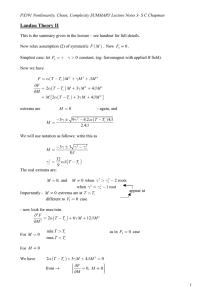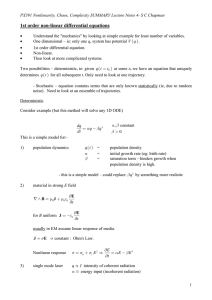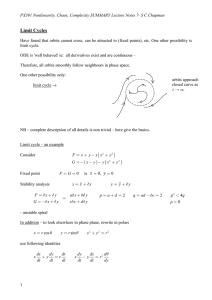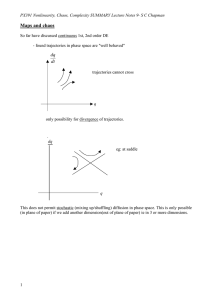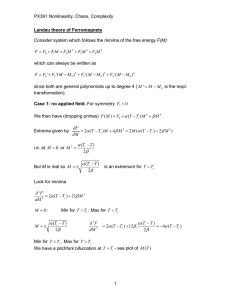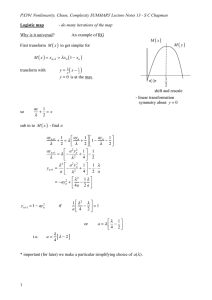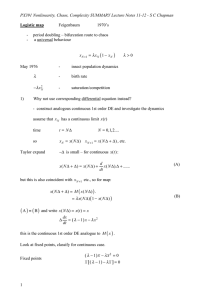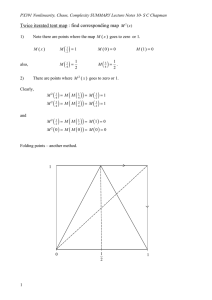Concepts
advertisement
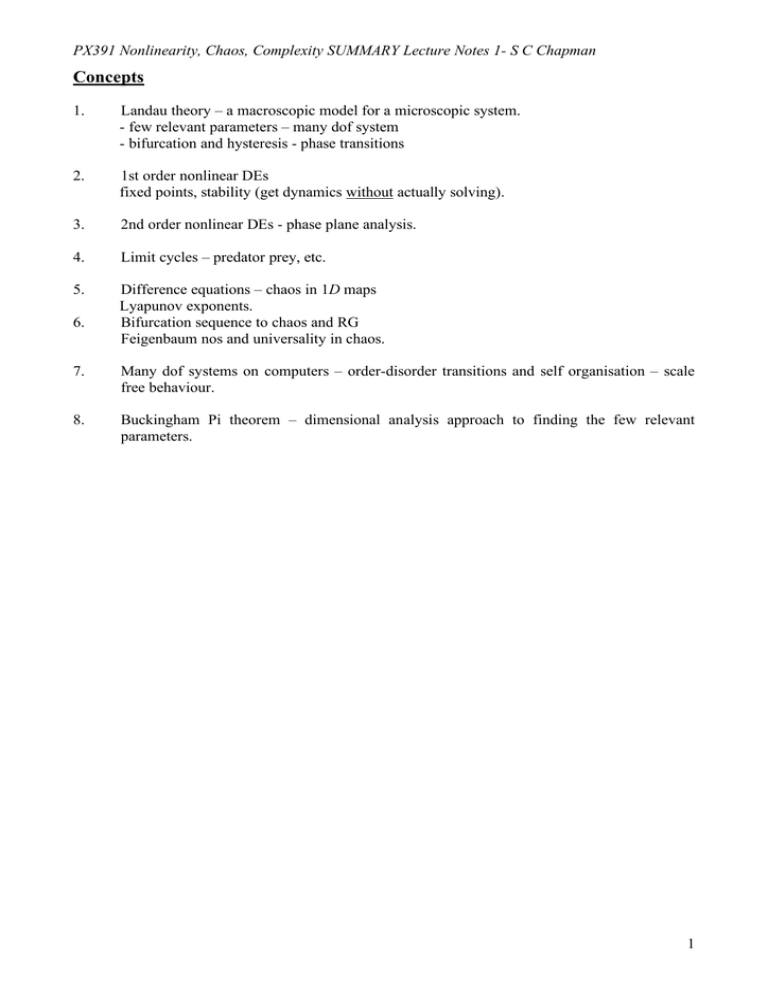
PX391 Nonlinearity, Chaos, Complexity SUMMARY Lecture Notes 1- S C Chapman Concepts 1. Landau theory – a macroscopic model for a microscopic system. - few relevant parameters – many dof system - bifurcation and hysteresis - phase transitions 2. 1st order nonlinear DEs fixed points, stability (get dynamics without actually solving). 3. 2nd order nonlinear DEs - phase plane analysis. 4. Limit cycles – predator prey, etc. 5. Difference equations – chaos in 1D maps Lyapunov exponents. Bifurcation sequence to chaos and RG Feigenbaum nos and universality in chaos. 6. 7. Many dof systems on computers – order-disorder transitions and self organisation – scale free behaviour. 8. Buckingham Pi theorem – dimensional analysis approach to finding the few relevant parameters. 1 PX391 Nonlinearity, Chaos, Complexity SUMMARY Lecture Notes 1- S C Chapman Introduction – universality (linear systems) Most of what you have seen so far is linear: An example: pendulum d 2! + " 2 sin ! = 0 dt 2 ! ! - Nonlinear since sin ! term – d! d 2! not e.g. !, , 2 ( ! linear ) dt dt d 2! Immediately assume ! small than sin ! ! ! and 2 + " 2! = 0 . dt - now linear – solution of the form ! ! Acos( "t + # ) A, ! from initial conditions. - this is an example of general description of particle motion in potential V "V ( x ) md 2 x = ! "x dt 2 dV here … dx - function of x V (x) only x x0 V has a minimum – expect small oscillations about x0 - find frequency ω of oscillations. Lets (do properly) linearize about x = x0 - Taylor expand x = x0 + ! x dV ( x ) dx V ( x0 ) is a minimum, = dV ( x0 + !x ) dx = dV d ! dV + ## dx dx #" dx $& d 2 ! dV &&!x + 2 ## % dx #" dx $& !x 2 + ... && % 2 r.h.s. evaluated at x0 d 2V ( x0 ) dV ! x + 0 (! x 2 ) (x)= 2 dx dx 2 PX391 Nonlinearity, Chaos, Complexity SUMMARY Lecture Notes 1- S C Chapman So, d 2V ( x0 ) d 2! x = ! ! x + 0 (! x 2 ) dt 2 dx 2 d 2x =m 2 dt m d 2V ( x0 ) dx 2 ! d2 V (x) dx 2 x = x0 ‘Linearize’ means terms 0 (! x 2 ) ! 0 ( ! x ) ie: all functions are linear in ! x equivalent to ! x ! 1 small displacements from x0 . etc. V !!( x0 ) d 2"x V !!( x0 )"x , 2 =" m m dt * hence this linear equation is universal – works for any (conservative) system with a minimum in V ( x ) provided ! x is small enough. (V !! > 0 ) " ! is real - recover linear pendulum equation with ! 2 = [intuitively obvious – anything with potential ⇒ !x V (x) - oscillations and know ! x ( t ) - oscillates about x0 "roughly" sinusoidal ] x Other advantage of linear equations – principle of superposition ie: if you have the simplest situation – ie: one oscillator ! = Acos( "t + # ) any system can be obtained by ! ( t ) = ! Aj cos( " j t + # j ) which is why we have Fourier theory. Here we have j linear coupled oscillators (normal modes) each one has two constants ( Aj , ! j ) and one frequency ! j . Another equation you will have seen – wave equation ! 2! 1 ! 2! = !x 2 c 2 !t 2 c constant Nonlinear of c ( ! ) - dispersion, diffusion. Linear equation 'works' for any waves, ie: water waves, light waves… universality. 3 PX391 Nonlinearity, Chaos, Complexity SUMMARY Lecture Notes 1- S C Chapman !! !! = " !t !x 2 Diffusion equations ! constant linear. So linear equations – good news was - universality – (works for anything) - superposition – (only need simplest solution – just add them up) - Not many parameters, eg: oscillator – just ω waves - just c diffusion ! - Not many variables - eg: !, ".... Now real life is Nonlinear - a problem! - superposition fails (try it!) - bad news Good news: - still get universal equations (so don't need to learn many) - only need few order parameters - only need a few variables. Last point → few variables – often this is because system appears to have many variables but relevant physics can be described by few eg: Magnet – many spins – but we can understand it by just following M (total magnetisation). Why this is so is a current hot topic in physics (self organisation, critical phenomena, complexity). Normalisation and Dimensional Analysis – (more later) Normalisation (boring but important) Have written down universal equations eg: ! 2! 1 ! 2! = !x 2 c 2 !t 2 wave equation experimentally you have displacementtimewrite ! = !*!0 x=x L * then sub in t = t *T Normalised units! x (meters) t (seconds) T seconds L meters !0 - whatever ! is measured in ! 2 !*!0 1 ! 2 !* !0 = !x *2 L2 c 2 !t *2 T 2 ! 2 !* ! 2 !* 1 L2 = *2 2 " 2 !x *2 !t c T 4 PX391 Nonlinearity, Chaos, Complexity SUMMARY Lecture Notes 1- S C Chapman L2 c is a velocity T2 ! is anything (this is why it is universal). this is dimensionless if c 2 = So, to do the maths you can work in (*) units – or to solve on a computer. [Also found out what c meant – and if equation is correct!] 5
